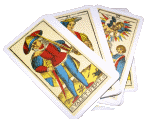
Haindl Tarot
ACE OF STONES
The eagle lands on the rock. This image is as powerful as any in the Haindl Tarot. Part of the same truth as the Hanged Man and the Star, it shows us the fundamental realms joined together: the Earth and the Sky, the "ordinary" reality and Spirit, feminine and masculine, the Receptive and the Creative, dark and light, wisdom and daily life. We could almost expect the image to come out of an ancient ritual performance, with a dancer dressed as an eagle.
The eagle, the Spirit, comes down to the rock. We have seen how the Haindl Tarot reverses the concept that we must leave the Earth behind and ascend to the sky. Among many Native Americans, particularly Plains people, such as the Lakota, the vision quest includes the idea of personal ascent. According to Black Elk, men go up to a mountain, women to a hilltop. The eagle represents God because it dwells in the air, and it represents light because it flies up into the Sun. But the person who receives the vision does not seek to leave the world. Instead, he or she returns to the daily life of the tribe. The vision makes the man or woman a whole person, able to experience the world more completely. The vision, therefore, descends to the person.
We can call the Ace of Stones the gift of the Earth, but it is also the gift of vision. This is the clue to the Haindl Tarot, this joining of realities. Traditionally this suit, as Coins, or Pentacles, has meant wealth and prosperity. But wealth is more than money. It means a good life. The Earth is soft and green, but without flowers or trees. The image is one of simplicity, showing what really matters, the Sky, the Earth, the rainbow as the universal symbol of beauty and gifts - and the Spirit beings who fill the world but remain invisible to those of us who refuse to recognize them. We can see these beings as colored lights flickering over the card.
Today most Native Americans live in poverty, not by choice but from 400 years of colonial oppression. Their traditional cultures did not seek out vast wealth, especially in North America. The highest value went to a spiritual relationship with the Earth. This value has not disappeared. Recently in the United States a high court ruled that the U.S. government illegally drove a tribe of Native Americans from their land in the nineteenth century. As compensation the courts awarded the tribe a vast amount of money, enough to make every one of them rich. The Indians refused. They want their land and will continue to fight for its restoration, despite the seeming hopelessness of victory. (The land includes major cities which would come under tribal law if the land belonged officially to the Native Americans.)
The eagle is an aspect of Wakan-Tanka, usually translated as "Great Spirit." We see in the eagle the same colors as in the Spirit beings: white on the top and the tail features, gold on the beak and claws, red on the wings. A line in the Ghost dance (the central ritual of Native American revival in the late nineteenth century) says, "Wambi galeshka wanna ni he o whoe." In English, this reads, "The Spirited Eagle is coming to carry me away." The rock acts like the cosmic bubbles on so many of the other cards. It fills the same place in this card as the ball of light in the High Priestess. Erica Haindl has pointed out that if you look at it long enough, the rock begins to turn, just like the ball of light (see Vol. 1). But a rock is a natural object, something hard and real. The symbol of potentiality, of new life in so much of Hermann Haindl's work is manifested here as the rock of reality. The Ace of Stones signifies the way Haindl has manifested his own vision in his Tarot.
DIVINATORY MEANINGS
In readings, this powerful card represents the good things in life - health, prosperity, beauty, even good weather if the reading should concern something where weather is an issue. It shows that these things come to the person at this time in her or his life as a gift. The person needs to recognize this and to use the gift in a positive way so as not to waste it. The card implies finding a greater truth, even visions, in daily life.
REVERSED
Reversed, the Ace of Stones does not indicate sickness, poverty, or bad weather. The gift remains but the person tends not to appreciate it. The person becomes materialist in the narrow sense, valuing the objects rather than their meaning. The reversed Ace of Stones can show conflicts over money or prosperity.










